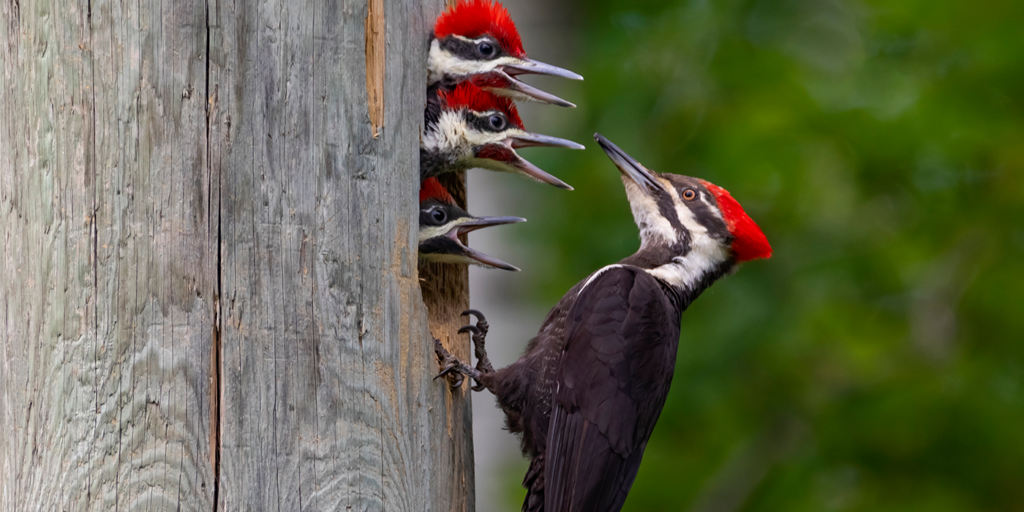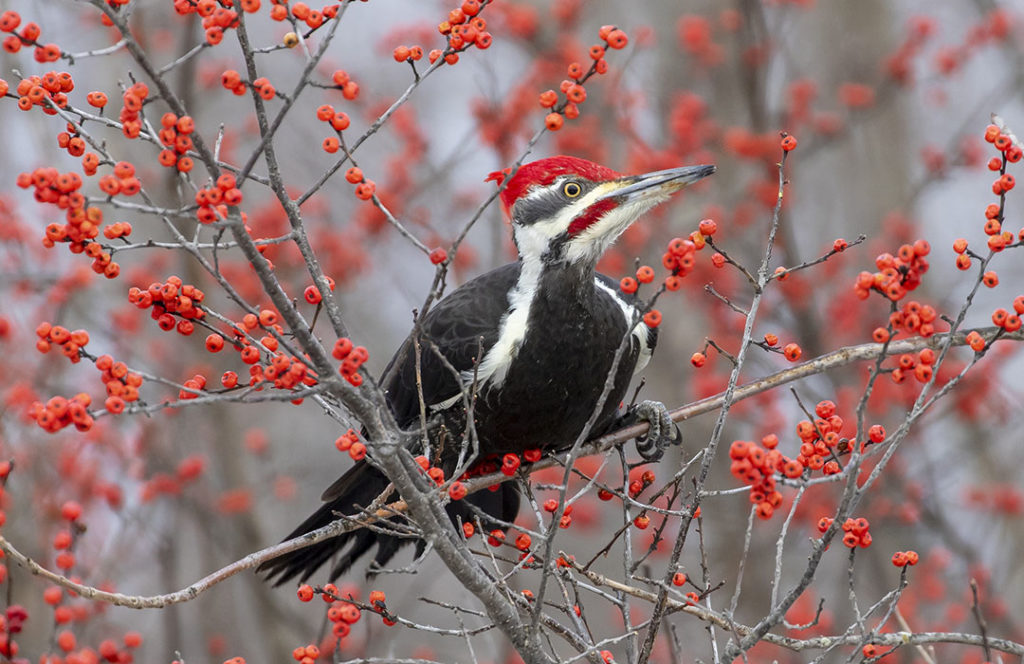The Pileated Woodpecker Is a Keystone Species and Protecting Its Nest Cavities Is Good for Nature
The Pileated Woodpecker is one of those species that are so loved by newbie birders—you can’t confuse it with anything else! The largest woodpecker in Canada, it sports a bright red crest and a heavy black body with white stripes. Its loud resonant drumming that increases in tempo, is unmistakable.
And it’s more than just a striking presence. The Pileated Woodpecker is what ecologists call a keystone species—which is why its recent inclusion in schedule 1 of the amended Migratory Bird Convention Act Regulations is so important.
A keystone species is defined as “an organism that has a significant influence on the ecosystem it occupies that is disproportionately large compared to its abundance or biomass”1,2. Renowned ecologist Daniel Simberloff demonstrated that keystone species “are functionally linked to a suite of other species; thus, management for the persistence of keystone species benefits other species by maintaining key ecosystem functions or structures.”2
Just what is a keystone species? It’s been defined as “a relatively uncommon species that is functionally linked to the [perseverance] of an array of other species and plays a critical role in the organization and/or functioning of the ecosystem.”3

For the Pileated Woodpecker, that role lies in the holes that they drill. A simple action that has multiple benefits for the ecosystem—including supporting nutrient cycling, managing insect populations, and manufacturing new niches for other species to occupy. They create opportunities for foraging, sheltering, and nesting. For example, cavities that aren’t used for their own nesting are used for years thereafter by an array of different species. In this sense, the Pileated Woodpecker is engineering the ecosystem, a role that easily supports over 30 species.
One of the most noteworthy changes to the amended Regulations of the Migratory Birds Convention Act is the inclusion of the Pileated Woodpecker on the list of species for which nesting sites are protected after active nesting. On behalf of the 30-plus species of wildlife that depend upon Pileated Woodpeckers during their life histories, thank you for making this important change to the Regulations Minister Guilbeault.
Sadly, a recent article in the National Post by Bryan Passifiume completely misses the point of why the Pileated Woodpecker is protected under the new regulations. Instead, it instead perpetuates a false narrative that the bird’s inclusion is somehow misguided. We beg to differ.
Passifiume admits in his article that full-time business lobbyists (representing seven major business groups, including the Forest Products Association of Canada and the Canadian Association of Petroleum Producers, have been pressuring the Federal Government to weaken a key biodiversity clause in the amended regulations of the Migratory Bird Convention Act. Passifiume describes what amounts to a thoughtful and progressive requirement of the regulations as an “onerous burden” to these business oligarchs.
What having Pileated Woodpecker on the list of species for enhanced nest site protection does, is force the people cutting down trees to do their work carefully rather than recklessly. Is that a bad thing?

Over thirty species depend on the Pileated Woodpecker for their survival. Here is the list of 27 species from only two studies3,4 in Northwestern North America:
- Wood Duck
- Hooded Merganser
- Common Merganser
- Barrow’s Goldeneye (Special Concern)
- Common Goldeneye
- Bufflehead
- American Kestrel
- Flammulated Owl
- Western Screech Owl
- Northern Pygmy Owl
- Northern Saw-whet Owl
- Boreal Owl
- Vaux’s Swift
- Hairy Woodpecker
- Northern Flicker
- Hairy Woodpecker
- Brown Creeper
- Northern flying squirrel
- Red squirrel
- Douglas’ Squirrel
- Bushy-tailed Woodrat
- American Marten
- Ringtail
- Fisher
- Little brown Myostis (Endangered)
- Big brown Myotis
- Silver-haired Bat
Many of these species use old Pileated Woodpecker nest sites to reproduce: a secure and safe place to have their babies and nurture them through the most vulnerable part of their lives.
Modernizing the Regulations of the Migratory Bird Convention Act is long overdue and greatly welcomed by anyone concerned about bird populations. But the amendments announced on June 9 cannot be the end of it. The Regulations need a permitting scheme, in part to make them workable, and to make those whose actions affect migratory bird populations accountable for their actions.
North America has lost about one-third of its wild bird populations over the last 50 years, largely because of human actions that take nature for granted. It’s time we celebrate the progressive change to policies and regulations that will help our bird populations and the rest of nature recover.
- 1 Power, M.E. Tilman, D., Estes, J.A., Menge, B.A., Bond, W.J., Mills, L.S., Daily, G., Castilla, J.C. Lubchenco, J., & Paine, R.T.. (1996) Challenges in the quest for keystones. BioScience. 46(8), 609-620. https://doi.org/10.2307/1312990
- 2 Simberloff, D.. (1998) Flagships, umbrellas, and keystones: is single-species management passe in the landscape era? Biological Conservation, 83(3),247-257. https://doi.org/10.1016/S0006-3207(97)00081-5
- 3 Aubry, K.B. & Raley, C.M. (2002) The Pileated Woodpecker as a Keystone Habitat Modifier in the Pacific Northwest. USDA Forest Service, PNW Research Station, Olympia, WA. https://www.fs.fed.us/psw/publications/documents/gtr-181/023_AubryRaley.pdf
- 4 Bonar, R.L. (2000). Availability of pileated woodpecker cavities and use by other species. Journal of Wildlife Management, 64(1), 52-59. http://www.jstor.org/stable/3802974
Referenced:
- Bull, E. L. & J. A. Jackson (2020). Pileated Woodpecker (Dryocopus pileatus), version 1.0. In Birds of the World (A. F. Poole, Editor). Cornell Lab of Ornithology, Ithaca, NY, USA. https://doi.org/10.2173/bow.pilwoo.01
- Imbeau, L., Monkkonen, M. & Desrochers, A. (2002). Long-Term Effects of Forestry on Birds of the Eastern Canadian Boreal Forests: a Comparison with Fennoscandia. Conservation Biology, 15(4),1151-1162. https://doi.org/10.1046/j.1523-1739.2001.0150041151.x



